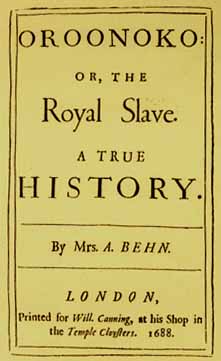Plot summary
Oroonoko is a relatively short novel whose full title is Oroonoko: or, the Royal Slave. The novel concerns Oroonoko, the grandson of an African king, who falls in love with Imoinda, the daughter of that king's top general.
The novel opens with a statement of veracity, where the author claims to be writing no fiction and no pedantic history. She claims to be an eyewitness and to be writing without any embellishment or theme, relying solely upon reality. What follows is a description of Surinam itself and the South American Indians there. She regards the locals as simple and living in a golden age (the presence of gold in the land being indicative of the epoch of the people themselves). It is only afterwards that the narrator provides the history of Oroonoko himself and the intrigues of both his grandfather and the slave captain, the captivity of Imoinda, and his own betrayal. The next section is in the narrator's present; Oroonoko and Imoinda are reunited, and Oroonoko and Imoinda meet the narrator and Trefry. The third section contains Oroonoko's rebellion and its aftermath.
Literary significance
As the British and American disquiet with slavery grew, Oroonoko was increasingly seen as protest to slavery. Wilbur L. Cross wrote, in 1899, that "Oroonoko is the first humanitarian novel in English." He credits Aphra Behn with having opposed slavery and mourns the fact that her novel was written too early to succeed in what he sees as its purpose (Moulton 408). Indeed, Behn was regarded explicitly as a precursor of Harriet Beecher Stowe. In the 20th century, Oroonoko has been viewed as an important marker in the development of the "noble savage" theme, a precursor of Rousseau and a furtherance of Montaigne, as well as a proto-feminist work. Most recently, Oroonoko has been examined in terms of colonialism and experiences of the alien and exotic.
The New World setting
Blending literary elements is always a difficult task; Aphra Behn took on the challenge with Oroonoko. Restoration literature had three common elements: the New World setting, courtly romance, and the concept of heroic tragedy. John Dryden a prominent playwright in 1663, co-wrote the The Indian Queen and wrote the sequel The Indian Emperor. Both plays have the three aspects of Restoration literature, “Behn was certainly familiar with both plays” influencing her writing which is seen in the opening of Oroonoko.


No comments:
Post a Comment
Note: Only a member of this blog may post a comment.